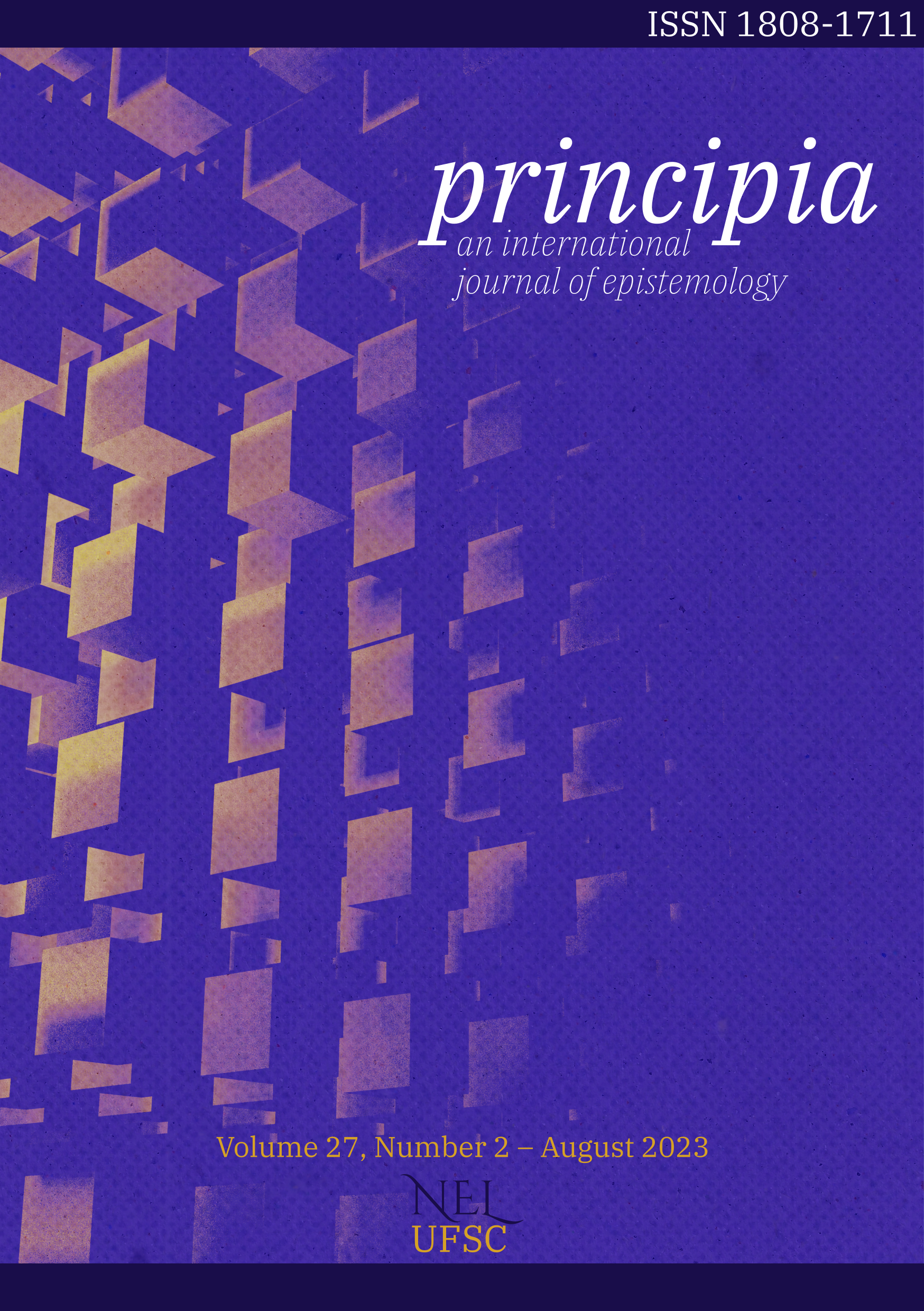Pons Asinorum para a Lógica Proposicional Clássica
DOI:
https://doi.org/10.5007/1808-1711.2023.e83312Palabras clave:
Lógica Proposicional Clássica, Lógica inventiva, Inventio medii, Informação semânticaResumen
A Lógica Contemporânea dá pouca ou, mesmo, nenhuma atenção à construção de argumentos para uma conclusão dada, diferentemente do que ocorre nos Analíticos Anteriores, de Aristóteles. O procedimento de Aristóteles foi, posteriormente, compilado sob a forma de um diagrama lógico conhecido como “Ponte de Asnos” (Pons Asinorum). Neste trabalho proponho um procedimento para a construção de argumentos para uma dada conclusão, no âmbito da Lógica Proposicional Clássica, abstraído do procedimento de Aristóteles. Utilizo a noção de informação semântica como fio de Ariadne para a obtenção do procedimento.
Citas
Angelelli, I. 1970. The Techniques of Disputation in the History of Logic. The Journal of Philosophy, 67(20): 800-815.
Aristóteles. 1986. Organon III. Analíticos Anteriores. Tradução e notas de P. Gomes. Lisboa: Guimarães Editores.
Bochenski, I.M. 1961. A History of Formal Logic. Indiana: University of Notre Dame Press.
Carroll, L. 1977. Symbolic Logic. Editado, com anotações e uma introdução por W. W. Bartley, III. New York: Clarkson N. Potter.
Castro-Manzano, J. M. & Medina-Delgadillo, J. 2019. Pons asinorum: una versión terminística. In: J. M. Ángeles De León et al. (eds.) La edad media desde América Latina: aportes a la tradición: XVII Congresso Latinoamericano de Filosofía Medieval: actas. p.163-179. Ciudad Autónoma de Buenos Aires: Celina Ana Lertora.
Castro-Manzano, J. M. & Medina-Delgadillo, J. 2020-2021. El pons scholasticorum. Revista de Filosofía Diánoia, 65(85): 55-72. https://doi.org/10.22201/iifs.18704913e.2020.85.1655. Acesso: 10.03.2023.
Craig, W. 1957. Three uses of the Herbrand-Gentzen Theorem in Relating Model Theory and Proof Theory. Journal of Symbolic Logic, 22: 269-285.
Garrido, M. 1983. Lógica simbólica. 6ª. reimpresión revisada. Madrid: Editorial Tecnos.
Gómez Álvarez, J. E. 2019. Puente de los asnos: una propuesta de aplicación para la enseñanza. Andamios, 16(41): 87-101.
Hamblin, C. L. 1976. An Improved Pons Asinorum. Journal of the History of Philosophy, 14(2): 131-136. https://doi.org/10.1353/hph.2008.0365. Acesso: 10.03.2023.
Hintikka, J. & Bachman, J. 1991. What If…? Toward Excellence in Reasoning. Mountain View: Mayfield.
Hintikka, J. & Halonen, I. 1999. Interpolation as Explanation. Philosophy of Science, 66: S414-S423.
Kneale, W. & Kneale, M. 1991. O Desenvolvimento da Lógica. Tradução de M. S. Lourenço. 3a. edição. Lisboa: Fundação Calouste Gulbenkian.
Matthews, G. B. 2007. Santo Agostinho: a vida e as idéias de um filósofo adiante de seu tempo.Rio de Janeiro: Jorge Zahar Editor.
Peirce, C. S. 1890. The ‘Pons Asinorum’ Again: Mr. Peirce sets forth the History of the Phrase from the Times of Duns Scotus’s Followers. New York Daily Tribune. Tuesday, 6 January 1890, p. 14, c. 5.
Thomas, I. 1965. The Later History of the Pons Asinorum. In: A.-T. & C. Parsons (eds.) Contributions to Logic and Methodology in Honor of J.M. Bochenski. p.142-150. Amsterdam: North-Holland.
Descargas
Publicado
Número
Sección
Licencia
Derechos de autor 2023 Frank Thomas Sautter

Esta obra está bajo una licencia internacional Creative Commons Atribución-NoComercial-SinDerivadas 4.0.

Principia http://www.periodicos.ufsc.br/index.php/principia/index is licenced under a Creative Commons - Atribuição-Uso Não-Comercial-Não a obras derivadas 3.0 Unported.
Base available in www.periodicos.ufsc.br.



